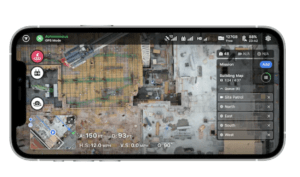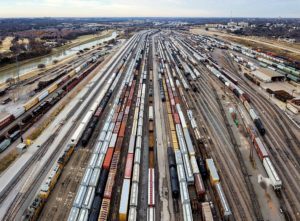 DroneDeploy has been one of the top names in drone mapping since they started in 2013. They’ve evolved with the industry: and now, DroneDeploy goes beyond drone mapping to unified reality capture – allowing customers to gather data from multiple sources, aerial and ground, to get the intelligent insights they need.
DroneDeploy has been one of the top names in drone mapping since they started in 2013. They’ve evolved with the industry: and now, DroneDeploy goes beyond drone mapping to unified reality capture – allowing customers to gather data from multiple sources, aerial and ground, to get the intelligent insights they need.
Continue reading below, or listen:
At DJI AirWorks today, DroneDeploy took the stage with customer BNSF Railway, one of the largest freight railway networks in North America. James Pipe, DroneDeploy VP of Product and Nick Dryer, BNSF Senior Manger of UAS, discussed the future of autonomous reality capture.
Since inception, co-founder Mike Winn has been clear that DroneDeploy’s goal was to become a “one-button” solution. Over time, they’ve continuously evolved the DroneDeploy platform to streamline the workflow, becoming more automated and easier to use. They’ve already proven the case for automated inspections with Boston Dynamic’s ground robot “Spot,” pushing data directly into DroneDeploy. The introduction of the DJI Dock provides an opportunity to do the same with aerial data capture. In the first AirWorks Keynote, Pipe said “Our goal is a complete autonomous workflow – where the tools just do their work and capture the data every day.”

The Evolution of Using Drones for Data Capture at BNSF
BNSF uses drones for multiple uses – they began by inspecting bridges, a job which Dryer says is “absolutely terrifying” to do in the traditional manner, with an inspector hanging over the side. Dryer says the projects have evolved from simply gathering images on an SDK card to being able to generate AI-powered insights from 3D models.
Now, the company has widely adopted drone technology and is working with experimental, long-range hybrid aircraft to survey rail infrastructure – along with smaller, faster aircraft like the Mavic 3 that flies at 70 mph 30 – 40 feet over the tracks to gather different data. Data is pushed directly to DroneDeploy for processing, creating 2D and 3D models from which stakeholders throughout BNSF can get critical measurements and maintenance insights. Aerial data is used for security, inspections, damage assessments, maintenance, and more.
“In the very near future, I would say that every inch of our rail network will have been documented with high resolution aerial data,” says Dryer.
From Automated to Autonomous
An automated system performs the tasks a user sets based on pre-defined parameters: an autonomous system can adapt it’s performance of a task based on changes in the environment.
For drones, Pipe says that capture autonomy has 3 stages, moving from automated to autonomous.
- Basic capture: the drone conducts a pre-programmed waypoint mission, avoiding collisions and returning home.
- Adaptive capture: the drone is able to adapt the plan while in progress given observed conditions.
- Full Autonomy: the drone is able to conduct missions based on outside stimulus: which could be a timed schedule, or an event like a security breach.
Analysis autonomy also has 3 stages:
- Upload and Processing: Data is delivered automatically to a processing system.
- Extracting scalar data from raster data: Robots or drones are able to read tools like gauges, and input the actual reading into another system: as opposed to simply delivering an image of the gauge which would still need to be interpreted by a human.
- Reporting/work order: Data is gathered and analyzed, and may trigger more actions: such as integrating the data into a workflow tool to generate a work order.
The Future Vision for BSNF: Autonomous Capture, Autonomous Analysis
Right now, BNSF manages capacity by keeping track of a network of pilots across the country. Soon, however, Dryer says that they will also manage autonomous tools like a drone dock, which may be available to perform a mission. Dryer envisions BNSF Having multiple drone-in-a-box solutions stationed every so many miles all along the railway, so that frequent inspections like heat inspections can be performed autonomously. Dryer says that the goal is “Rapid Response Survey” – the ability to complete surveys easily and quickly, delivering the data as quickly as possible.
Dryer sees many uses for autonomous data processing, also. Locating specific cars in a crowded railyard can consume up to 4 hours a day for railyard managers. If drones can fly through a rail yard reading the characters on the sides of rail cars, they’re able to locate specific cars much more quickly – while managers can focus on other things.
“Autonomy is really about coverage,” says Pipe. “It’s about getting information rapidly from places where you can’t get a person there rapidly. That means that you’re going to be able to respond to any issue more quickly and more efficiently.”
The session comes on the same day that DroneDeploy announced their planned acquisition of StructionSite, a leading provider of ground-based reality capture for construction sites. The new partnership follows DroneDeploy’s earlier acquisition of New Zealand-based ground robotics software company Rocos, extending DroneDeploy’s capabiltiies to autonomous mobile ground robots. “We’re able to bring the best of aerial capture together with the best of ground capture,” says Pipe. “It’s really exciting.”
Read more about DroneDeploy:
- DroneDeploy Conference 2022: Capturing Reality
- Drone Mapping Company DroneDeploy Releases Social Impact Report
- Drones for Residential Solar: Sunrun and DroneDeploy Find a Safer, More Efficient Way to Measure Rooftops
- DroneDeploy’s New Products Go Far Beyond Drones
- Latest DroneDeploy Funding Round Adds $50 Million for Expansion
Miriam McNabb is the Editor-in-Chief of DRONELIFE and CEO of JobForDrones, a professional drone services marketplace, and a fascinated observer of the emerging drone industry and the regulatory environment for drones. Miriam has penned over 3,000 articles focused on the commercial drone space and is an international speaker and recognized figure in the industry. Miriam has a degree from the University of Chicago and over 20 years of experience in high tech sales and marketing for new technologies.
For drone industry consulting or writing, Email Miriam.
TWITTER:@spaldingbarker
Subscribe to DroneLife here.







[…] More… […]